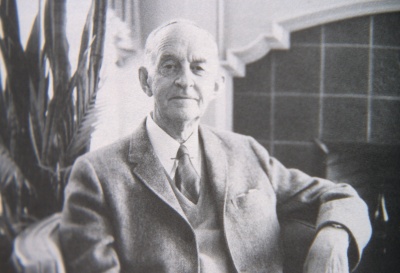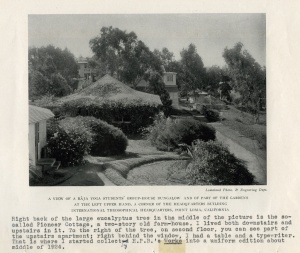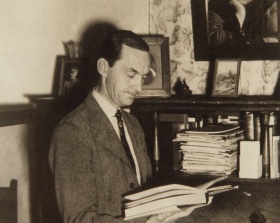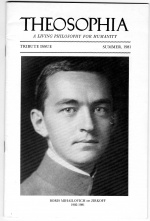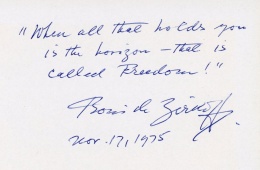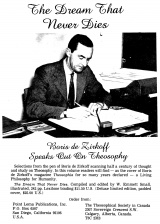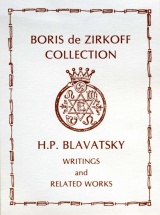Boris de Zirkoff
Boris Mihailovich de Zirkoff (1902–1981) was a relative of H. P. Blavatsky and the editor of her written works. After living for many years in the Point Loma community, he moved to Los Angeles in 1942, where he created and edited the periodical Theosophia. He expressed his philosophy of life:
The only thing that counts with me ... is what WORK men do, Theosophists and others, for the benefit of mankind, for the spiritual enlightenment of others, for the Cause of Light and Peace, entrusted into our care by the Masters and their Messengers, from age to age."[1]
Early years
De Zirkoff was born in Petrograd, Russia [now known as Saint Petersburg] on March 7, 1902. His mother was Lydia Dmitriyevna von Hahn.[2] who was a second cousin to Helena Petrovna Blavatsky. His father was Mihail Vassilyevich de Zirkoff, a general in the Russian Imperial Army.[3] According to a friend, scholar W. Y. Evans-Wentz, de Zirkoff was "in his own right a Baron."[4] Boris described his family relationship to Helena Petrovna Blavatsky in this way:
Her father and my grandfather (my mother's father) were cousins. There was a considerable difference in age between the two branches of the family; hence I was born after HPB had died. This makes me something like a grand-nephew of HPB.[5]
In another account he wrote that "H.P.B.'s father, Peter von Hahn, and my mother's father, General Dmitry von Hahn, were first cousins."[6] Modern genealogists would call this relationship "second cousin once removed."
Young Boris was tutored at home. He had an aptitude for languages, eventually mastering Russian, English, Swedish, German, and French, as well as the classics. As a boy in Russia, Boris was aware of his famous relative, but knew little of her. "I became interested in H.P.B. when I was a boy of twelve. I came across references to her in books. Her name was anathema in my family so I just kept my interest in her to myself."[7]
Turmoil during the Russian Revolution in 1917 forced Boris to flee with his mother and stepfather across Finland.
Introduction to Theosophy
After settling in Sweden in the home of Mrs. Wicander, he discovered The Secret Doctrine. According to one account, he found a Swedish translation in a library,[8] but another version of the story tells that he first saw HPB's masterwork in the home of the Russian Consul.[9] The Theosophical Movement was well established in Sweden at that time. De Zirkoff met Katherine Tingley during one of her European tours as head of the Universal Brotherhood and Theosophical Society, and she invited him to live at Point Loma in California.
Life at Point Loma
Late in 1923, the 21-year-old de Zirkoff left Sweden and sailed on the S. S. Leviathan from Southampton to New York, arriving December 21.[10] He moved to the Point Loma community near San Diego, California. There he became acquainted with pupils of HPB including Dr. Henry T. Edge, Charles J. Ryan, Reginald Machell, and Dr. Herbert Coryn.
He became a naturalized citizen of the United States on December 18, 1936.[11]
Collected Writings project
For many years, BdeZ engaged with utter dedication in editing the collected writings of Helena Petrovna Blavatsky. Asked how he came to undertake that project, he said,
When I came to Point Loma in 1924 and began to read some of the old theosophical publications like The Theosophist and Lucifer it became obvious to me that H. P. B. had written a great deal more than The Secret Doctrine and Isis Unveiled. Nothing had been done about it. Her writings were, to my understanding, voluminous but inaccessible except to those who could consult old publications which, obviously hardly anybody could do except those in large centres. So I felt that there was a very real and urgent need to have her collected writings put together in uniform editions. In 1924 or in 1925, I began doing just that, quietly, without saying very much to anybody. A couple of years later, I told Katherine Tingley, who was the Leader in Point Loma, that I was doing so and from then on it became an official undertaking.[12]
While at Point Loma, his expenses were covered, but after he left in 1942, he was "supported by donations from people all over the world who are interested in seeing the project completed."[13] The massive body of his correspondence demonstrates his perseverance and scholarship in approaching this work, and the warm personal relationships he maintained with fellow Theosophists, librarians, scientists, and other sources around the world. A correspondent in London, Mrs. Mary L. Stanley, researched numerous questions for him in the British Museum's library (now the British Library). He wrote a special acknowledgement in his Foreword to Volume 6:
Her able, many-sided and sustained research-work in the British Museum contributed very materially to the accuracy of the many quotations which had to be checked, and of the various data that had to be verified. This exacting and painstaking labor stands as a major contribution not only in the production of former volumes, but in the preparation of the MSS. for volumes yet to be published.
In a letter to her he joked, "You are acquiring a wreath of laurels, like classic poets, as a result of all this scholastic work. I wonder whether this will affect very materially your next incarnation! One good thing would be, not to run into me next time, not even by remote control!"[14]
De Zirkoff's work received international recognition and cooperation from the major Theosophical organizations. In 1981 he was awarded the Subba Row Medal of the Theosophical Society (Adyar) to acknowledge his superb contributions to Theosophical literature.[15]
Editorship of Theosophia
.
Theosophia was an independent quarterly periodical published in Los Angeles from May-June 1944 to Summer 1981. The final issue, pictured here, was a tribute to the recently deceased editor.
Throughout its existence, the magazine maintained a neutral attitude toward the various Theosophical organizations, and a high standard of scholarship. Every issue began with an article by Boris de Zirkoff. Schedules of lectures were often listed for the Los Angeles and San Diego areas. Book reviews and transcriptions of radio lectures and interviews were occasionally included.
Excerpts from Blavatsky's writings were frequently featured. The best writers from all the Theosophical traditions had articles printed on its pages; new writings were combined with reprints from older periodicals. Some well-known authors were William Quan Judge, Henry Steel Olcott, Gottfried de Purucker, Mary K. Neff, Sven Eek, Ernest Wood, Henry T. Edge, Charles Johnston, Josephine Ransom, Manly P. Hall, L. Gordon Plummer, Herbert Coryn, George William Russell writing as AE, and Julia Keightley writing as Jasper Niemand. Harold W. Dempster and Arthur L. Joquel were among the most frequent contributors.
Tours and lectures
De Zirkoff was also a fine lecturer. In 1959 he toured Europe, speaking in Amsterdam, The Hague, and Utrecht.[16] In London he stayed with Laurence and Phoebe D. Bendit, and spent considerable time reviewing archival materials that related to his compilation of Helena Petrovna Blavatsky's Collected Writings. He was especially interested in the 1887-1897 minutes book of the Blavatsky Lodge.[17]
As a close friend of Stephan Hoeller, he was frequently invited to speak at the Besant Lodge in Hollywood, California.
His address at the 1975 Centennial World Congress, entitled "The Dream that Never Dies," was "truly a high point of that week-long gathering."[18]
Here are some of his other lecture engagements:
- April 15, 1959 at Amsterdam on "Man Matching the Atom"
- April 23, 1959 at Amsterdam on "H.P.B.'s Original Teachings Concerning the Ancient Wisdom and the Occult Hierarchy"
- October 11, 1975 at Krotona School of Theosophy on "Problems of Editing the Works of H. P. Blavatsky"
- 1950s in Los Angeles area on "Private Class in Theosophy"
Views on reconciliation movement
When a friend urged Mr. de Zirkoff to hold a meeting to bring together Adyar Society President N. Sri Ram and the heads of other Theosophical groups, he rejected the idea and proposed instead that something new should grow out of the old structures:
No, I am having no special meeting of any kind here for Sri Ram... I am not a good man to bring various opposing factions together, and showing them some sort of neutral ground where they can meet. I like the idea in the abstract, but I am not the man to do so.
Personally, I prefer to try and build something new, to try and erect a new house, plant a flower garden (metaphorically speaking), elevate a banner which everybody can see if they clear their eyes of dust, and proclaim a principle, which all can hear if they wash their ears! If they like it, they will come along and become unified in helping it to grow. If they do not like it, they are welcome to stay behind and lick whatever kind of chops they have...
If you want to know what I feel about the Movement, it is this: I do not believe it can be unified. I do not even think it should be except on very general lines of common objective and distant goal. But there is a new growth, a fresh shoot in the Movement; this is to be encouraged, nourished, tended; it is to be seen in many continents and lands. It will be used for future efforts. When the new shoot is grown up, the rest will appear like a bunch of weeds compared with its luxuriant growth and sturdy nature.[19]
Later life
For many years Mr. de Zirkoff had wanted to visit the headquarters of the original Theosophical Society in Adyar, Chennai, India, and especially to visit the Adyar Archives. Finally in December 1977 he was able to travel there to meet the former archivist Zoltán de Álgya-Pap with whom he had corresponded for many years, who was also visiting.[20]
Early in 1981, the twelfth volume of the Collected Writings series was published, and the next two volumes were at the printer. Radha Burnier, President of the Theosophical Society based in Adyar wrote to "Dear Brother Boris" on February 23rd:
The members of the General Council and myself, unanimously considered you as the fittest person to receive the Subba Row medal now. The work you have done in preparing the Collective writings of our great Founder, H.P. Blavatsky, is monumental. Every token of the appreciation that is felt in respect of your lifelong labour, appears to be inadequate. However, in grateful recognition of your untiring efforts during several decades, to make available to the world the wealth of knowledge contained in H. P. B.'s writings, I have the honour to request Miss Joy Mills to present to you, on behalf of the Society the Subba Row medal.[21]
Radha Burnier truly appreciated in the breadth and depth of scholarship that went into the Collected Writings project, since during the 1950s she had responded with patience and precision to hundreds of questions that Mr. de Zirkoff sent to the Adyar Library and Research Centre concerning Sanskrit and Tamil terms. Many other friends and coworkers wrote of Boris de Zirkoff when, after a long illness, he passed away on March 4, 1981. A final issue of Theosophia, the Tribute Issue, was filled with letters praising their friend's dedication, scholarship, and helpfulness, his wit, humor, and simple, undemanding lifestyle. Joy Mills quoted a letter Boris had written to her:
The only thing I live for and work for is the perpetuation and dissemination of genuine Theosophy whether it be through the words of H. P. B. or those who have remained true to her message and the instructions of Those standing behind her.[22]
Awards and honors
In 1981, shortly before he died, Mr. de Zirkoff was awarded the Subba Row Medal for his huge contribution to Theosophical literature.[23]
Writings
In addition to his major contributions in compiling the Collected Writings and in publishing Theosophia, Mr. de Zirkoff frequently wrote other articles and books.
Periodicals
The Union Index of Theosophical Periodicals lists over 300 articles by Boris de Zirkoff, and dozens more are about de Zirkoff and his books.
In addition to his own Theosophia, the periodicals included Theosophy, Theosophy World, Theosophy in New Zealand, Theosophy in Australia, The American Theosophist, Discovery, The Canadian Theosophist, The Eclectic Theosophist, Le Lotus Bleu, The Theosophical Path, The Theosophical Journal, Theosophical Digest, and The Theosophical Forum.
Mr. de Zirkoff also contributed articles to periodicals that have not yet been indexed. The August, 1933 issue of the Theosophical Club publication Lucifer calls for support of the Collected Writings project,[24] for example. When he visited Adyar for the first (and probably the only) time in December 1977, he was asked to contribute an article to the Madras Theosophical Federation Bulletin.[25]
In 1983, after Boris de Zirkoff had died, W. Emmett Small compiled and edited fifty articles from Theosophia into a volume published as The Dream That Never Dies: Boris de Zirkoff Speaks Out on Theosophy.
Other books and shorter works
- Hypnotism, Mesmerism. and Reincarnation: Some Startling Facts in the Light of Esoteric Philosophy. Los Angeles: Blavatsky Writings Publication Fund, 1956.
- What of Reincarnation?. La Habra, CA: Ande Herald Press, 1974.
- Rebirth of the Occult Tradition: How the Secret Doctrine of H. P Blavatsky was Written. Adyar, Chennai, India: Theospihcal Publishing House, 1987. Reprinted in 1990. It was also issued in a Dutch translation in 1980.
- Bibliography to When Daylight Comes: A Biography of Helena Petrovna Blavatsky by Howard Murphet. Wheaton, IL: Theosophical Publishing House), 1975.[26]
Additional resources
Articles
- International Group of Theosophists in Theosophy World.
Archival legacy
Boris de Zirkoff left his fine library to the Henry S. Olcott Memorial Library of the Theosophical Society in America, where it is held intact in the Rare Books Room. His papers, including his massive correspondence and research files used in his work on H. P Blavatsky's collected writings and her letters, are in the Archives Department.
His correspondence with Walter A. Carrithers, Jr. is available in the Walter A. Carrithers, Jr. Papers of the Theosophical Society in America Archives.
Audio recordings of lectures
- "H.P.B.". 1970. 30 minutes. Recorded at the Theosophical Society in America in Wheaton, Illinois. Mr. de Zirkoff pays tribute to the enduring literary works of H.P. Blavatsky and her important role as a co-founder of the Theosophical Society.
- "Science and Theosophy". 1974. 90 minutes. Recorded at the Theosophical Society in America in Wheaton, Illinois. This refers to H.P. Blavatsky's assertion in The Secret Doctrine that the basis for esotericism is the infinite divisibility of the atom.
- "The Life of HPB". 1958. 49 minutes. Recorded at the Theosophical Society in America in Wheaton, Illinois. The early life of Madame H. P. Blavatsky prior to the formation of the Theosophical Society.
- "The Dream that Never Dies". 1975. 43 minutes. Talk #4. The Centenary World Congress, held in New York City on November 15, 1975 celebrated the centenary of the Theosophical Society, which was founded in New York on 1875. Boris de Zirkoff presented the fourth lecture.
Notes
- ↑ Boris de Zirkoff to A. J. Hamerster. February 14, 1937. Boris de Zirkoff Papers. Records Series 22. Theosophical Society in America Archives.
- ↑ "Zirkoff, Boris de". Theosophical Encyclopedia. Quezon City, Philippines: Theosophical Publishing Company, 2006. 688-689. Available at Theosopedia,
- ↑ John Cooper. "Last Link with H. P. Blavatsky Broken: Death of Boris de Zirkoff (1902-1981)." Theosophy in Australia 45.2 (June 1981): 232-233.
- ↑ Letter from W. Y. Evans-Wentz. Theosophia Tribute Issue 37.4 (Summer 1981): 4.
- ↑ Letter to Gertrud Bäzner. July 30, 1969. Boris de Zirkoff Papers. Record Series 22. Theosophical Society in American Archives, Wheaton, Illinois.
- ↑ Boris de Zirkoff letter to C. Jinarajadasa. February 15, 1937. Boris de Zirkoff Papers. Records Series 22. Theosophical Society in America Archives.
- ↑ L. H. Leslie-Smith, "An Interview with Boris de Zirkoff," The Theosophist 99 (March 1978), 161-163.
- ↑ John Cooper. "Last Link with H. P. Blavatsky Broken: Death of Boris de Zirkoff (1902-1981)." Theosophy in Australia 45.2 (June 1981): 232-233.
- ↑ "Zirkoff, Boris de". Theosophical Encyclopedia. Quezon City, Philippines: Theosophical Publishing Company, 2006. 688-689. Available at Theosopedia,
- ↑ New York, Passenger Lists, 1820-1957.Microfilm Roll: Roll 3431.
- ↑ U. S. Naturalization Record Indexes, 1791-1992 (Indexed in World Archives Project).
- ↑ L. H. Leslie-Smith, "An Interview with Boris de Zirkoff," The Theosophist 99 (March 1978), 162.
- ↑ L. H. Leslie-Smith, "An Interview with Boris de Zirkoff," The Theosophist 99 (March 1978), 162.
- ↑ Boris de Zirkoff letter to Mary L. Stanley. April 17, 1953. Boris de Zirkoff Papers. Records Series 22. Theosophical Society in America Archives.
- ↑ Anonymous, "Boris de Zirkoff Awarded the T Subba Row Medal," The American Theosophist 69.3 (March, 1981), 52.
- ↑ Letter from Lucie and Jan Molijn. Theosophia Tribute Issue 37.4 (Summer 1981): 12.
- ↑ Boris de Zirkoff letter to Laurence Bendit. July 9, 1959. Boris de Zirkoff Papers. Records Series 22. Theosophical Society in America Archives.
- ↑ Letter from Elwood and Alicia Schenck. Theosophia Tribute Issue 37.4 (Summer 1981): 9.
- ↑ Boris de Zirkoff letter to Russell Lloyd Jones. May 27, 1954. Boris de Zirkoff Papers. Records Series 22. Theosophical Society in America Archives.
- ↑ Boris de Zirkoff letters to Alwyn Miechel, September 9, 1977 and January 28, 1978. Boris de Zirkoff Papers. Records Series 22. Theosophical Society in America Archives.
- ↑ Letter from Radha Burnier. Theosophia Tribute Issue 37.4 (Summer 1981): 27.
- ↑ Letter from Joy Mils. Theosophia Tribute Issue 37.4 (Summer 1981): 24.
- ↑ Anonymous, "Boris de Zirkoff Awarded the T. Subba Row Medal," The American Theosophist 69.3 (March, 1981), 52.
- ↑ A sample from August 1933 is available in Box 1 of the Boris de Zirkoff Papers. Records Series 22. Theosophical Society in America Archives.
- ↑ Boris de Zirkoff, "East of Tomorrow," Madras Theosophical Federation Bulletin 25.1 (January 1978), 1. Available in Box 1 of the Boris de Zirkoff Papers. Records Series 22. Theosophical Society in America Archives.
- ↑ Boris de Zirkoff letter to Eugene V. Prostov. August 4, 1975. Boris de Zirkoff Papers. Records Series 22. Theosophical Society in America Archives.
